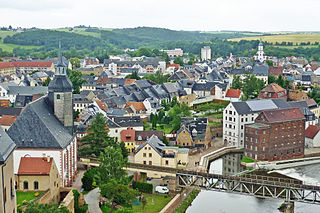
Böhlen is a town in Saxony, Germany, south of Leipzig. Its main features are a small airport and a power-plant. It is located in the newly built Neuseenland, the lakes created in the former open-pit mining areas.

Mittweida is a town in Saxony, Germany, in the Mittelsachsen district.

Erlau is a municipality in the district of Mittelsachsen in Saxony in Germany. In 1994 it absorbed the former municipalities Beerwalde, Crossen and Schweikershain, and in 1999 Milkau.

Rochlitz is a major district town in the district of Mittelsachsen, in Saxony, Germany. Rochlitz is the head of the "municipal partnership Rochlitz" with its other members being the municipalities of Königsfeld, Seelitz and Zettlitz.

Geringswalde is a town in the district of Mittelsachsen, in Saxony, Germany. It is situated 12 km northwest of Mittweida, and 27 km north of Chemnitz.

Gröditz is a town in the district Meißen, in Saxony, Germany. The town is located 12 km northeast of Riesa, and 7 km southwest of Elsterwerda.

Penig is a town in the district of Mittelsachsen, in the Free State of Saxony, Germany. It is situated on the river Zwickauer Mulde, 19 km northwest of Chemnitz. The old and the new castle were owned by the House of Schönburg from 1378 until 1945. Penig housed a concentration camp during World War II.

Räckelwitz (German) or Worklecy (Sorbian) is a municipality in Bautzen district, in the state of Saxony, Germany. The municipality of Räckelwitz has a population of 1,111 (2020) and is a member of the municipal association "Am Klosterwasser"(Zarjadniski zwjazk „Při Klóšterskej wodźe“).

Großschönau is a municipality in the district Görlitz, in Saxony, Germany located in the cross-border region with the Czech Republic. It used to be a famous Upper Lusatian center of Damask fabric production until the end of the 1980s. Since then it has turned into an area of tourism.

Cornelius Gustav Gurlitt was a German architect and art historian.

The village of Cämmerswalde in the municipality of Neuhausen/Erzgeb. lies in the south of the Saxon district of Mittelsachsen in eastern Germany. The state-recognised spa resort with its 800-year-old history, lies near Seiffen in the eastern part of the Western Ore Mountains not far from the Czech border. The village is a classic Waldhufendorf, with a length of over five kilometres. Cämmerswalde is divided into Oberdorf, Mitteldorf and Niederdorf. Since 1994 Cämmerswalde has belonged to the municipality of Neuhausen/Erzgeb., but used to be an independent parish with the hamlets of Deutschgeorgenthal, Haindorf and, from 1924, Neuwernsdorf and Rauschenbach.

Neuwernsdorf is a village in the municipality of Neuhausen/Erzgeb. in the extreme south of the Saxon district of Mittelsachsen, immediately next to the Czech border by Český Jiřetín and the Rauschenbach Dam.

Scharfenstein Castle lies on an elongated hill spur above the village of Scharfenstein, in the municipality of Drebach in the Ore Mountains of Saxony, Germany. The castle is one of 24 sites run by the state-owned State Palaces, Castles and Gardens of Saxony.

Satzung is a village in the Saxon municipality of Marienberg, which is in the district of Erzgebirgskreis in the German Ore Mountains.
Krakau (German) or Krakow (Sorbian) was a small town in what is now the district of Bautzen in Saxony, Germany. It was located within the Sorbian area, where many inhabitants traditionally speak the West Slavic Sorbian language, and it shared its name with the much larger Polish city. The town was entirely vacated in 1938 when the area became a military training area. After the war, the town was briefly repopulated, before the Soviet occupation troops again evicted the inhabitants to resume use of the area for military purposes. The town was destroyed.

Störmthal is a village, part of Großpösna in the Leipzig district in Saxony, Germany. It is known for its church in Baroque style. The organ, an early work by Zacharias Hildebrandt, was played and inaugurated by Johann Sebastian Bach and is still in mostly the condition of Bach's time.

Pötzschau is a village and a former municipality in Saxony, Germany. Since 2015, it is part of the town Rötha. It consists of the smaller parts Großpötzschau, Kleinpötzschau and Dahlitzsch. Pötzschau is south-east of Leipzig in the valley of the creek Gösel.

Hundshübel is a village in Erzgebirgskreis district of Saxony, forming a subdivision of the municipality of Stützengrün in the Ore Mountains. It is located north of Eibenstock Dam on federal highway B 169.

Siebenlehn is a district of the town Großschirma in Landkreis Mittelsachsen. Until 2003 it was a separate town. Upon fusion with the neighbouring rural municipality Großschirma on 1 September 2003, the town privileges were transferred to the joint municipality.

Bieberstein Castle is located on the left bank of the river Bobritzsch in Bieberstein, part of Reinsberg municipality, in Landkreis Mittelsachsen, Saxony.



























